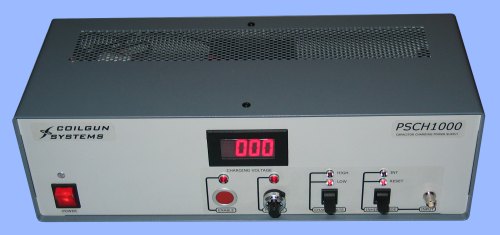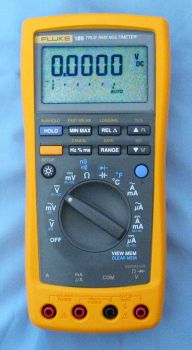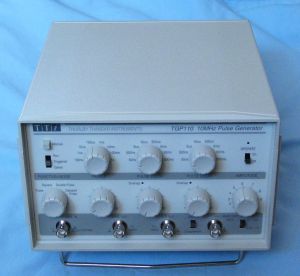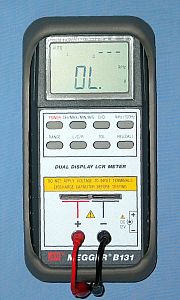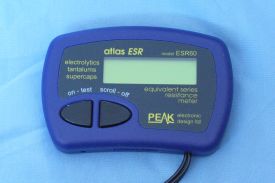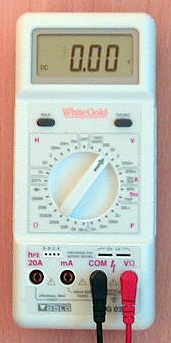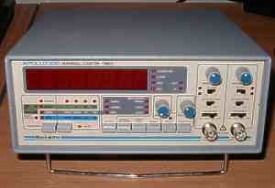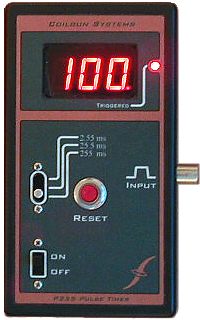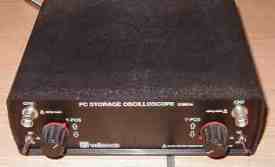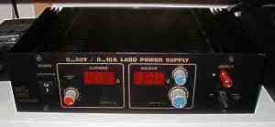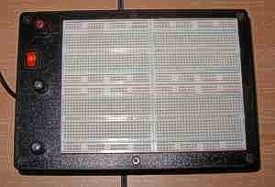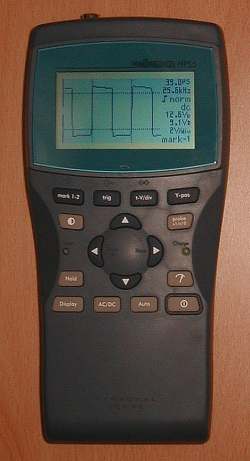|
|
|
Laboratory Equipment
If
you are intending to design and build a coilgun then you will need
some sort of test equipment. The absolute minimum is a multimeter.
Cheap digital multimeters are excellent value so there is no excuse
- buy one. Higher spec meters will have additional functions such
as transistor testing, frequency or inductance measuring etc. You
will need some sort of meter to assist you in building and
debugging circuits.
A
multimeter will get you quite far but if you are serious about coilguns
or electronics in general then you should seriously consider a digital
storage oscilloscope. This lets you capture and analyse transient
events such as the coil current waveform or the triggering pulse
etc. A bench top DSO such as those made by Tektronix will cost you
over $1000 but there are cheaper alternatives. A PC based DSO is
worth considering. Older versions of these 'scopes plug into the
PC's parallel port, but the latest models have USB connectivity.
You can also get a tiny 'scope that plugs directly into a USB port
- USBScope50.
All the functionality of a standard scope is available via the virtual
instrument interface. You can also save the raw data (as a .txt
file, or possibly other formats such as .csv) or a screen shot of
the trace. The cost of this type of kit is around $400 upwards.
If you're really serious then you could go for a data acquisition
card which can offer multiple input channels with programmable gain
and 12 or 16 bit resolution. With these cards you can write a programme
to sample the various channels and display the data as you see fit.
This is something for the hard core electronics fanatic. Something
to note with data acquisition equipment is the sampling rate. The
absolute minimum rate you should consider is 200KHz, this will allow
you to measure transient events of 250us with 50 data points of
temporal resolution. The 12 bit cards which run at around 200KHz
are not too expensive, coming in at around $300. Expect to pay well
over $1000 for a 16 bit card capable of 20MHz. As well as PC based
scopes there are handheld scopes and graphical multimeters. Handheld
scopes from the 'big' manufactures will cost you an arm and a leg,
however, there is at least one manufacturer which produces a cheap
HH scope for the hobby market. This costs around $200 and it can
be connected to a PC and the data downloaded and displayed.
Bear
in mind that you tend to get what you pay for. Most equipment aimed
at hobbyists will perform adequately but won't compare favourably
with high quality equipment. For example, take the PC DSO I own,
it functions well and does all I have asked of it - so far, but
compared to one of the compact bench DSO scopes from Tektronix,
it doesn't stand up.
You
might also want to get a prototyping board. I find this a great
help when designing and debugging circuits.
Here
is a list of my Lab equipment:
|
PSCH1000
Capacitor Charging Power Supply -
I've
been wanting to make a 'proper' capacitor charging power supply
for a while and eventually got around to making one. This
system is rated at 1000 V maximum output voltage at 100
or 50 W (selectable) nominal output power (this is a constant
power charger as opposed to constant current). After turning
on the mains the Enable button must be pressed to activate
the high voltage stage. The output terminal is a "safe"
type high voltage BNC connector on the rear panel. An Inhibit
input terminal (BNC) allows the supply to be either temporarily
inhibited or disabled (requiring the Enable button to be pressed
to operate the supply again). The inhibit period is controlled
by the pulse width on the BNC connector. The inhibit is useful
if the load capacitor gets discharged through a latching type
switch such as an SCR, where the current must be allowed to
decay until the SCR turns off.
The
supply is based on a flyback topology and uses an ETD59 type
core kit. Switching operates in current mode control with
a fixed off period. The flyback topology is naturally short
circuit proof but overvoltage protection circuitry is included
which disables the supply if the output exceeds 1200 V
(this protects the supply but not the load capacitor). If
the external circuit has the potential to ring then a reverse
biased clamp diode (with perhaps a dissipative resistor network)
needs to be placed across the load capacitor, otherwise the
flyback rectifier diodes would experience a high current surge
as they are forward biased by the negative voltage of the
ringing current. |
| Fluke
189 Multimeter
-
This
is an excellent meter that is capable of making highly accurate
measurements. It can store data in memory for later reference,
or for download to a computer via an infra red link. A backlite
for the LCD makes the meter easy to read in low light conditions.
The meter can be used to read currents of up to 20 A for brief
periods. |
|
| |
TTi
Pulse Generator -
This
generator is specifically designed to produce pulses. It can
generate single or double pulses with a large variation in
mark/space ratio. The pulses can be triggered manually, by
a gating pulse, or can run continuously. |
| MEGGER
LCR Meter
-
This
instrument can make accurate measurements of the parameters
that coilgunners like to know; namely inductance, capacitance
and resistance. The dissipation factor measurement allows
the ESR of a capacitor to be determined. Similarly, the Q
factor measurement can be used to calculate the resistance
of an inductive coil. All measurements can be conducted at
either 120 Hz or 1 kHz, to best reflect the actual
operating frequency. |
|
| |
Atlas
ESR Meter -
A
compact meter for measuring the capacitance and the effective
series resistance of various types of capacitor. The instrument
operates with a test frequency of 100 kHz.
|
| White
Gold DMM
-
This
is a good quality meter which can measure frequency, inductance,
capacitance and perform transistor testing in addition to
the standard voltage, resistance and current. It has the capability
to measure currents of up to 20A for short periods of time. |
|
|
|
Black Star 100MHz
Universal Counter Timer
-
A
counter timer could be considered a luxury item since most
timing measurements can be accomplished using a DSO. However
if many different simultaneous measurements are required then
additional equipment like this becomes an advantage. This
is a precision instrument and it get used for 'special' measurements.
|
|
P255 Pulse Timer
(Own Design) -
Considering
that the Black Star instrument is quite expensive I decided
to make a cheap and cheerful version of my own for every day
use. This is a very basic timer which has three ranges 2.55ms,
25.5ms and 255ms. It accepts a TTL compatible square pulse,
triggering on the positive edge and stopping on the negative
edge. It is based around a PIC16C84 microcontroller which
has electrically erasable program memory - excellent for prototyping
work. The latest devices use flash programme memory - PIC16F84.
If
you don't have a microcontroller programmer then you could
build a timer based on standard digital ICs. There is a great
description of such a timer at the Magnetic
Gun Club.
|
|
|
|
Velleman 32MS/s
Dual Channel PC DSO
(Kit) -
A
DSO is an essential piece of equipment for detailed experimental
work. At 32MS/s there is sufficient temporal resolution to
analyse very short transient events (by coilgun current pulse
standards). It comes as a kit and builds quite well. Calibration
can be a little annoying since the trimmer components are
very basic.
|
|
Pulsar V1.0
Square Pulse Generator
(Own Design) -
I
designed this little pulse generator as a general purpose
tool. It can output a square TTL compatible pulse with widths
from 1us to 100ms in 16 discrete steps e.g. 1us, 2us, 5us,
10us, 20us, 50us, 100us etc. It is based on a PIC12C509 microcontroller.
The pulse width is selected via a 4-way DIP switch.
|
|
|
|
Velleman 30V
@ 10A Bench Power Supply
(Kit) -
A
nice piece of equipment which has a current limiting facility.
It can't power a coilgun directly but it is useful for charging
batteries and capacitors as well as powering prototype circuits.
|
|
Powered
Prototyping Board
(Own Design) -
This is a basic board with +/- 15V supply @ 500mA per rail.
It's always a good idea to prototype a circuit before committing
the design to PCB. A case in point is the P255 timer I designed.
I must have had the microcontroller in and out about 10 times
trying to debug the firmware.
|
|
|
|
Velleman HPS5
Handheld 'Scope
This
instrument is a very useful piece of equipment having most
of the functionality of a standard 'scope. Since it is battery
powered it can be used to perform floating measurements
on parts of systems so long as the floating potential isn't
excessive - a few tens of volts is fine. If I have doubts
about making measurements on the PC based 'scope then this
one is put to use. Better to blow a £120 instrument
than a £1000 computer.
Two
things that are 'missing' from this 'scope are an adjustable
trigger level and an I/O port. In order to trigger on different
voltage levels of a waveform, the vertical position of the
waveform needs to be shifted. This can mean squeezing the
waveform into the upper or lower half of the screen to trigger
on the lowest or highest parts of the wave. An I/O port
would be useful for permanent storage of data. This feature
seems to have either been abandoned or is intended for future
versions of the instrument (there's a blanked off I/O hole
in the case)
|
|
|
|



